#decrement
Explore tagged Tumblr posts
Text
➕ Day 14 of Java Mastery: Unary Operators in Java Today’s topic is small but mighty — Unary Operators! Read Blog: https://wp.me/paNbWh-7W #Java #JavaMastery #Day14 #UnaryOperators #LearnJava #100DaysOfCode #CodeNewbie #JavaBasics #ProgrammingTips
#app developmennt#architecture of java#arithmetic#backend#beginner#binary#bitwaise#datastructures#decrement#execution flow#frontend#fullstack#fullstackdeveloper#increment#Java#operators#output#print#relational#unary
0 notes
Text
[millennial ledroptha curtain voice] sneks and doggos
0 notes
Text
Risk of Adverse Health Outcomes and Performance Decrements resulting from Non-Ionizing Radiation during Spaceflight
Sunlight exposure primarily affects the eye and skin and is mitigated by current standards and countermeasures. An increase in the prevalence of high-power ground-based lasers capable of reaching the ISS, and possibly even the Moon, could cause acute laser exposure damaging hemorrhagic retinal lesions resulting in temporary or permanent damage to vision. Directed Acyclic Graph […] from NASA https://ift.tt/q61jMbQ
#NASA#space#Risk of Adverse Health Outcomes and Performance Decrements resulting from Non-Ionizing Radiation during Spaceflight#Michael Gabrill
0 notes
Text
a cat is already a baby. a kitten is a baby cat, ergo a baby baby, more concentrated amount of baby. and it's smaller which adds to the baby density. cats are designed to be babies; they lie around the house and scream for food and need attention and are a good large baby size.
many dogs are bigger which decrease their baby density, and some of them have jobs which decrements from their baby qualities, which is why dogs are not quite as babyful as cats. a puppy is definitely a baby but it's not always a baby baby the way a kitten is.
babyness chart:
kitten -> puppy -> cat -> dog
do you understand?
1K notes
·
View notes
Text
she -- on my unsigned integer til I underflow a fat load (64 bits at least)
she ++ on my stack til i overflow
#underflowing an unsigned integer is like denial#small step by small step you make the integer needy#decrementing it slowly#until it reaches its limit#and explodes by going back to its maximum value#the limit being 0#programming#coding#c++#c programming#c++ programming#cool retro term#linuxposting
10 notes
·
View notes
Text



forehead decrement
(video)
154 notes
·
View notes
Text

On my Nova 1200, both the Cassette I/O board and the CPU board, were having issues passing serial tests. The /DS5 signal had incorrect logic levels, so I swapped some gates there and solved that problem.

Then the big problem, which took alot of work to diagnose and fix is specific to the CPU board. Using the Nova 1200 Logic Test tape (as in a virtual paper tape), tests were performed but no clear answer was forthcoming. It was failing, but the serial output messages weren't working right to tell us what failed, or now. I single-stepped through the program until we hit a test that didn't pass: the auto-incrementing addresses.


On a Nova, addresses 00020 thru 00027 auto-increment values when accessed. Meanwhile, addresses 00030 thru 00037 auto-decrement values when accessed. These functions worked, but unfortunately they were being activated on addresses 00120 thru 00137 which is not right at all.

It took days of tests, writing our own testing routines, and lots of oscilloscope captures before it was finally found. The N8859A quad-input NAND gate that is part of the address decode logic had started ignoring the /MBO13 and /MBO14 signals, meaning it was decoding incorrectly. That part has been replaced with a 74LS20 (despite technically requiring a 7440, Fairchild 9009, or the aforementioned Signetics part, which has no datasheet) -- it's fine. So, that problem finally got solved, but it was a pain because it's only using a single 4-input NAND gate to decode a 16-bit value for a 15-bit address. DG pulled this off by cycling through one nibble of the instruction at a time, synced with the four Processor Time Groups (PTGs).

See those cyan and magenta traces? When those go low, they should trigger the blue trace at the bottom to go high. There it is.

Anyway, that took alot to figure out, and it still doesn't work completely yet, but that's like 3 to 5 problems fixed in the span of a week, so I'd say that's pretty good progress.
39 notes
·
View notes
Text
WIP Wednesday
Was tagged by the talented and lovely @guacamolleee <3 Thank You!! <3 I actually got it in on Wednesday lol (barely)
Featuring: Emmrich having a Bad Time right after Rook got Fade Prison'd
They dragged their dispirited, beaten bodies through the Vi'Revas and then the decremented crew, to his surprise, promptly turned to Emmrich for their next move. He wasn’t sure if this handover was deemed natural, perhaps even apodictic, due to his knowledge of the Fade, his mature age, or his close proximity to Rook and whatever strategic insight that may have brought. What he did know was that their expectant eyes grated on his already overworn resolve. He wanted to hide away and coddle his growing despondency alone, not shepherd a gaggle of lost children. Reluctantly, and with a shaking hand rubbing at his jaw, Emmrich began rambling off various contacts of the Mourn Watch that should be foremost petitioned for their assistance, what questions needed to be posed and answered at present, which texts could provide possible correlative understanding—until Taash cut him off with the curt declaration that all of that could wait until the group washed the reeking blight from everyone’s sea-sodden hair and armor. The now anxious need to persevere and the near-audible ticking of the tireless clock looming overhead prompted Emmrich to argue, but he eventually sighed and conceded. He retreated to the washroom he shared with Magdalena, and Emmrich startled to a halt in front of the large mirror with a dismayed gasp. A macabre and messy mark, stark and red and tragic, stained his cheek where his darling had laid a mid-battle kiss. That bloody souvenir was the final strike that sundered Emmrich’s tenuous composure. Rough, hiccuping sobs broke free and wracked his tired body, filling the quiet washroom as he curled inward and hunched over the vanity’s counter.
Tagging uhhh these cool kids 😎 so sorry if you've already done it, ily <3 @caughtnyact @velvet-apricots @redheadsramblings @silshinobii @spare-coffin @paramortality @basic-x-witch @the-bear-and-his-sunbird @pseudospaceship @thequeenofthewinter @sofiemystique
32 notes
·
View notes
Text
Book of Bill spoilers under cut
I know this isn't nearly what everyone's talking about when it comes to this book but the added context and filling in the blanks about Stanford's story absolutely breaks my heart.
For his whole childhood and young years he was ostracized for his birth defect and interest in the abnormal, only getting recognition for his gifted genius and when he finally had the chance to put his smarts to good use surrounded by people who would get him the only person who was ever there for him ruined his chances (albeit accidentally) and sent a wrecking ball to his entire future.

Although he excelled with the cards he was dealt and found a study he was passionate about he was all alone, despite being the smartest person in Gravity Falls (and possibly all of Oregon) he was still very socially stunted and struggled even talking to a waitress at a diner, alone with his studies until he met Bill who while becoming his muse and aiding him tremendously with his research also seemed to truly connect to him in a way no human ever could and they appeared to grow a strong bond maybe even blossoming into a little situationship. Through this he reconnected with his old colleague roommate who was not only willing to help with a groundbreaking technological breakthrough for pretty much nothing but is also the first to show Stanford true human kindness (even at his own decrement) that he most likely hasn't felt since the fallout with Stanley which he reciprocate.
He was thriving in his element, he didn't have many friends but when push came to shove he only needed the two. The future was looking bright and he was happy.
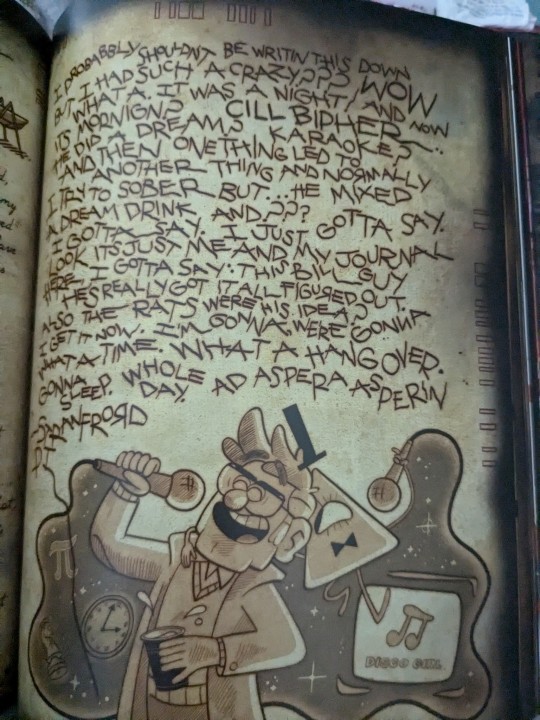

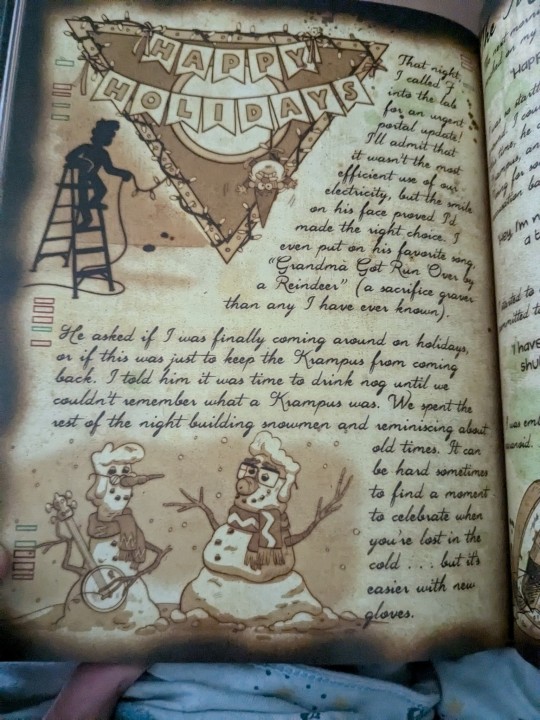
Then in one fell swoop it all came crashing down.
The secrets of his research and progress came out in the end and in the span of what I assume is a week he not only lost his one human friend but his muse, his friend, his sidepiece, the only being ever who truly recognized and understood him became his worst monster and tormentor and what's worse is that the only person that could possibly help him has been drawn away. He's left completely and more alone than he ever was.
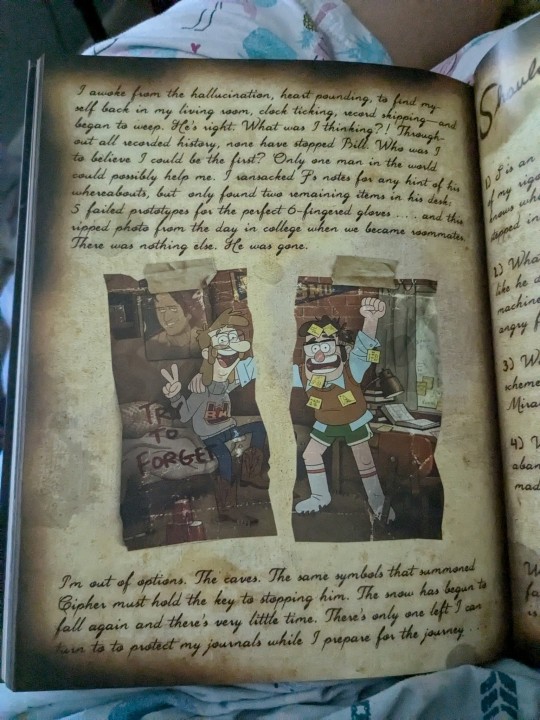
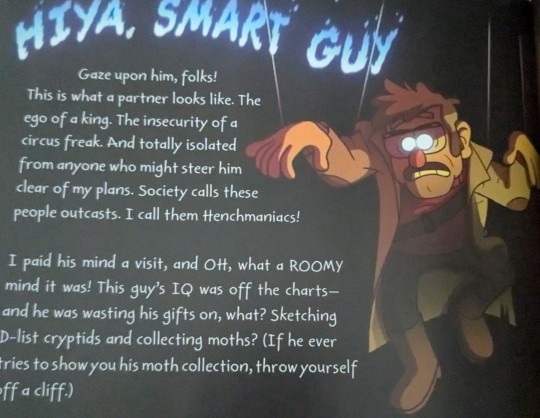
Growing maddened, desperate and with no one else to turn to he reaches out the con man who ruined his future 30 years ago despite fears disaster and mockery hoping he can help.
And we all know how that ended...

When I first watched Gravity Falls when I was younger I never gave too much thought about Ford but reading through his pages in The Book Of Bill and piecing everything together made me cry.
But the only thing that made me cry harder was seeing the picture of him in the present day, surrounded by the people who love and care about him.
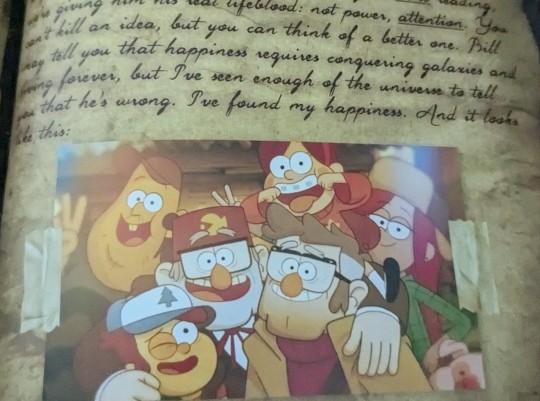
"I found my happiness and it looks like this." :')
#don't mind me just crying over the tragic relationship drama of cartoon scientist at the tender hour of 4:A.M#Alex how are you gonna crush my heart with the ripped photo and then have bill spiraling about the divorce just waiting on the next page#book of bill got me feeling things i wasn't expecting#gravity falls#stanford pines#book of bill#book of bill spoilers#blatherings of a blathermouth
56 notes
·
View notes
Text
noticing the fact that he wore a shirt with the word "home" on its chest (in big bold red letters) while deciding to let go of the only thing close to home he's ever found, while literally being on the verge of dying, while finally realising that there is someone who will always choose him, has been decremental to my mental health and obliterated my sanity to unreachable realms


#its not that im not thinking about jack and joker every waking moment like a freak on wheels is running thru my head#ive been so deeply exhausted this week#and wdym jack and joker wont be there to exhaust me some more this Monday :(#i miss them so much RE-WATCH TIME SOON#jack and joker#jack and joker u steal my heart
20 notes
·
View notes
Text
Because of the way floating point numbers work, as they get larger there comes a point where you actually can't increment them. They simply get too imprecise to encode a difference of 1.0f. Which is to say, for sufficiently big (or, I guess "magnitudinous") values, x == x + 1. For high-precision floats, like IEEE 754 double-precision and quadruple-precision and x87 extended-precision floats (among others), these thresholds are really quite large -- in the trillions at the lowest -- but for the humble 32-bit float it's not tremendously big, only 16,777,216 (or -16,777,216).
Now, when it comes to programs that do lots and lots of incrementing and decrementing, what does my mind go to? Brainfuck. Brainfuck is built almost entirely around incrementing and decrementing. Historically, this has been a source of problems for implementers, as there's no immediately obvious way to handle overflows or underflows. Should the cell array wrap around? Should the program simply segfault? Should cells be 8-bit, or bigger? Should we simply continue allocating memory as the cell pointer gets further from the origin? How should we handle negative cell pointer values?
Well, we can kill ...one bird with ...another, already dead bird here: make everything use 32-bit floats! We don't have to worry about overflows anymore, the cell pointer will just get "stuck" after a while! This also really simplifies the memory model: we can just statically allocate 33,554,433 doublewords on program startup (mere megabytes) and be assured the cell pointer will never escape into uninitialized memory. We don't have to worry about the cell values themselves either -- they'll bang up against the same thresholds.
I wrote a highly unsophisticated compiler (with NASM as an assembler backend) several months ago using this idea, and I think I'd like to come back to it -- there's a funny sort of inelegant elegance here.
17 notes
·
View notes
Text
Risk of Adverse Health Outcomes and Decrements in Performance due to Inflight Medical Conditions
Regardless of mission length or objectives, all human spaceflight requires some degree of in-mission medical support. The transition from a gravitational environment to microgravity, coupled with living in a closed-loop environment, can result in variable physiological effects and health risks. For example, anticipated physiological impacts of the microgravity environment include fluid redistribution and subsequent head […] from NASA https://ift.tt/BvOq0et
#NASA#space#Risk of Adverse Health Outcomes and Decrements in Performance due to Inflight Medical Conditions#Michael Gabrill
0 notes
Text

"One day I received a large brown envelope in the mail. It was sent to me by Doctor Volkhard Knigge, the director of the Buchenwald Memorial Center. He enclosed a small envelope with his congratulatory note, and described what was in the envelope, so, in case I didn’t have the strength to look, I wouldn’t have to. The envelope contained a copy of the original daily report on the camp’s prisoners for February 18, 1945. In the “Abgänge”, that is, the “Decrement” column, I learned about the death of Prisoner #64,921 – Imre Kertész, factory worker, born in 1927. The two false data: the year of my birth and my occupation were entered in the official registry when I was brought to Buchenwald. I had made myself two years older so I wouldn’t be classified as a child, and had said worker rather than student to appear more useful to them.
In short, I died once, so I could live. Perhaps that is my real story."
Kertész Imre
#thinking about this forever and ever#fateless is a book everyone should read imo#kertész imre is just a writer who i physically cannot praise enough#urgrhrgrhgrhrgh me when i fucking get you kertész imre me when i get you#barking
9 notes
·
View notes
Text
hey wanna hear about the crescent stack structure because i don't really have anyone to tell this to
YAYYYY!! THANK YOU :3
small note: threads are also referred to internally as lstates (local states) as when creating a new thread, rather than using crescent_open again, they're connected to a single gstate (global state)
the stack is the main data structure in a crescent thread, containing all of the locals and call information.
the stack is divided into frames, and each time a function is called, a new frame is created. each frame has two parts: base and top. a frame's base is where the first local object is pushed to, and the top is the total amount of stack indexes reserved after the base. also in the stack is two numbers, calls and cCalls. calls keeps track of the number of function calls in the thread, whether it's to a c or crescent function. cCalls keeps track of the number of calls to c functions. c functions, using the actual stack rather than the dynamically allocated crescent stack, could overflow the real stack and crash the program in a way crescent is unable to catch. so we want to limit the amount of these such that this (hopefully) doesn't happen.
calls also keeps track of another thing with the same number, that being the stack level. the stack level is a number starting from 0 that increments with each function call, and decrements on each return from a function. stack level 0 is the c api, where the user called crescent_open (or whatever else function that creates a new thread, that's just the only one implemented right now), and is zero because zero functions have been called before this frame.
before the next part, i should probably explain some terms:
- stack base: the address of the first object on the entire stack, also the base of frame 0
- stack top: address of the object immediately after the last object pushed onto the stack. if there are no objects on the stack, this is the stack base.
- frame base: the address of the first object in a frame, also the stack top upon calling a function (explained later) - frame top: amount of stack indexes reserved for this frame after the base address
rather than setting its base directly after the reserved space on the previous frame, we simply set it right at the stack top, such that the first object on this frame is immediately after the last object on the previous frame (except not really. it's basically that, but when pushing arguments to functions we just subtract the amount of arguments from the base, such that the top objects on the previous frame are in the new frame). this does make the stack structure a bit more complicated, and maybe a bit messy to visualize, but it uses (maybe slightly) less memory and makes some other stuff related to protected calls easier.
as we push objects onto the stack and call functions, we're eventually going to run out of space, so we need to dynamically resize the stack. though first, we need to know how much memory the stack needs. we go through all of the frames, and calculate how much that frame needs by taking the frame base offset from the stack base (framebase - stackbase) and add the frame top (or the new top if resizing the current frame in using crescent_checkTop in the c api). the largest amount a frame needs is the amount that the entire stack needs. if the needed size is less than or equal to a third of the current stack size, it shrinks. if the needed size is greater than he current stack size, it grows. when shrinking or growing, the new size is always calculated as needed * 1.5 (needed + needed / 2 in the code).
when shrinking the stack, it can only shrink to a minimum of CRESCENT_MIN_STACK (64 objects by default). even if the resizing fails, it doesn't throw an error as we still have enough memory required. when growing, if the new stack size is greater than CRESCENT_MAX_STACK, it sets it back down to just the required amount. if that still is over CRESCENT_MAX_STACK, it either returns 1 or throws a stack overflow error depending on the throw argument. if it fails to reallocate the stack, it either throws an out of memory error or returns 1 again depending on the throw argument. growing the stack can throw an error because we don't have the memory required, unlike shrinking the stack.
and also the thing about the way a frame's base is set making protected calls easier. when handling an error, we want to go back to the most recent protected call. we do this by (using a jmp_buf) saving the stack level in the handler (structure used to hold information when handling errors and returning to the protected call) and reverting the stack back to that level. but we're not keeping track of the amount of objects in a stack frame! how do we restore the stack top? because a frame's base is immediately after that last object in the previous frame, and that the stack top is immediately after the last object pushed onto the stack, we just set the top to the stack level above's base.

6 notes
·
View notes
Text
Sellsword Demo
Wrote this on a long drive so sorry if it sucks
Instinct dice:
Instinct is defined by a die level, from d4 to d20. When your instinct is incremented, you'll change the die to the next highest die (d4->d6->d8->d10->d12->d20); decrement is the same in reverse.
Wounds
When an instinct roll is under your number of accumulated wounds, decrement your instinct.
After a duel, roll a number of d4s equal to your resistance & add the results. If your number of wounds is over the result, you die.
Resistance
Resistance is how many effects you can ignore in a round of a duel. Average person has a resistance of 0.
If your resistance is negative, every attack against you automatically inflicts +1 wound.
Parrying
If your opponent makes an attack, you can spend points of your resistance to roll an equal number of instinct dice. If one of the instinct results is over your opponent's roll, reverse any attack effects onto them. You can spend resistance into the negatives, but parrying will not reverse the automatic wounds.
Death
The average person is no longer considered a player after death.
Inflicting instant death is against the samurai code.
Duels:
At the start of most duels, opponents roll instinct; highest goes first. Each killer gets a turn in a round, which allows them the chance to strike.
When you strike, roll your instinct.
On a 1, your enemy chooses an effect that is applied to you
On a 2-3, choose an effect that is applied to you
On a 4-5, choose an effect that is applied to your target
On a 6+, choose 2 effects that are applied to your target.
If you roll 10+, choose the two effects, then roll a strike again with the next lowest die level. If your resistance is 3+, consider the last roll in your turn as the only extra result; if your resistance is 2-, consider every roll as a result.
Effects:
1.) +1 wound
2.) incapacitate
3.)-1 resistance
4.)decrement instinct
5.) scar (scars permanently change a character's path; removing a limb, traumatizing, instilling lust for vengeance, etc)
6.) death
Survival
If you survive a duel, increment your instinct, and gain +1 mastery.
If your mastery goes over your current resistance, gain +1 resistance and reset your mastery to 0.
Further Mechanics/Setting
probably FitD-inspired.
Gain rep as a sellsword, samurai, or kingpin on the streets of Goldmine.
Vibes
Ghost Dog: Way of the Samurai, Wu Tang Clan, RZA, Samurai Champloo, Ten Thousand Days For The Sword, Nine Sols, Blue Eye Samurai, Kill Bill, Neon White
#might use this blog like i actually intended to originally#as in post shit and see what people think before committing to it#ttrpgs#indie ttrpg#ttrpg design#sellsword
7 notes
·
View notes